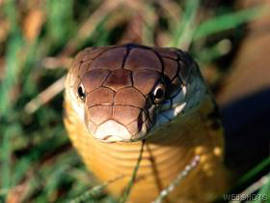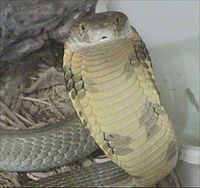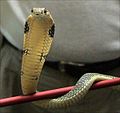BIOLOGÍA: Giant King Cobra. The King Cobra (Ophiophagus hannah) is the world's longest venomous snake, with a length that can be as large as about 5.5 m (18 ft).[1] This species is widespread throughout Southeast Asia and parts of India, and is found mostly in forested areas. Note that this species is highly aggressive and dangerous.
King Cobra
From Wikipedia, the free encyclopedia
| King Cobra | ||||||||||||||||
|---|---|---|---|---|---|---|---|---|---|---|---|---|---|---|---|---|
 | ||||||||||||||||
| Conservation status | ||||||||||||||||
| Scientific classification | ||||||||||||||||
| ||||||||||||||||
| Binomial name | ||||||||||||||||
| Ophiophagus hannah Cantor, 1836 | ||||||||||||||||
Distribution of the King Cobra |
The King Cobra (Ophiophagus hannah) is the world's longest venomous snake, with a length that can be as large as about 5.5 m (18 ft).[1] This species is widespread throughout Southeast Asia and parts of India, and is found mostly in forested areas. Note that this species is highly aggressive and dangerous. Actually, contrary its name, King cobra is not a kind of cobra at all,it belongs to its own genus. The way to separate it and the common cobras is to identity its size and the figures which appear on its neck. King cobra's size is usually larger than the common cobras, and the stripe on its neck is like a word ^ instead of a double or single eye(s) shape.King cobra's genus name, Ophiophagus, literally means "snake-eater", and its diet consists primarily of other snakes, including rat snakes, sizeable pythons and even other venomous snakes (including kraits, cobras and smaller members of its own species). The venom of the King Cobra is primarily neurotoxic, and the snake is fully capable of killing a human with a single bite.[2] The mortality rate from a bite can be as high as 75%.People who are bitten by this species have a low chance to survive.[2][3][4]
Contents[hide] |
[edit] Profile
The King Cobra is a large and powerful snake, averaging 3.6–4 m (12–13 feet) in length and typically weighing about 6 kg (13.2 lb). A particularly large specimen was kept captive at the London Zoo and grew to 5.7 m (18.8 ft) before being euthanized upon the outbreak of World War II.[5] The skin is either olive-green, tan, or black and it has faint, pale yellow cross bands down the length of the body. The belly is cream or pale yellow, and the scales are smooth. The head of a mature snake can be quite massive and bulky in appearance, though like all snakes, they can expand their jaws to swallow large prey items. It has proteroglyph dentition, meaning it has two short, fixed fangs in the front of the mouth which channel venom into the prey like hypodermic needles. The male is larger and thicker than the female. The average lifespan of a King Cobra is about 20 years.
[edit] Habitat
The King Cobra is widespread, but not common, across South and South-east Asia. It lives in dense highland forests,[1][6], preferring areas dotted with lakes and streams. King Cobra populations have dropped in some areas of its range because of the destruction of forests, but despite this the snake is not listed by the IUCN as in danger of becoming extinct. It is, however, listed as an Appendix II Animal within CITES.[7]
[edit] Hunting
King Cobras, like other snakes, receive chemical information (“smell”) via their forked tongues, which pick up scent particles and transfer them to a special sensory receptor (Jacobson's Organ) located in the roof of its mouth.[1] When the scent of a meal has been detected, the snake will flick its tongue to gauge the prey's direction (the twin forks of the tongue acting in stereo); it will also rely on its keen eyesight (King Cobras are able to detect moving prey almost 100 m [300 feet] away), intelligence[8] and sensitivity to earth-borne vibration to track its prey.[9] Following envenomation, the King Cobra will begin to swallow its struggling prey while its toxins begin the digestion of its victim.[1] King Cobras, as with all other snakes, do not have rigidly fixed jaws. Instead, the jaw bones are connected by extremely pliable ligaments, enabling the lower jaw bones to move independently of each other.[1] Like other snakes, the King Cobra does not chew its food, instead it swallows its prey whole. The expansion of the jaw enables the snake to swallow prey much larger than its head.[1]
King Cobras are able to hunt at all times of day, although it is rarely seen at night, leading most herpetologists to classify it as a diurnal species.[1][2]
[edit] Diet
The King Cobra's diet is mainly composed of other snakes (ophiophagy): both non-venomous snakes such as pythons and venomous snakes including kraits[2][10] When food is scarce, King Cobras may also feed on other small vertebrates such as lizards, birds, and rodents. In some cases, the cobra may “constrict” its prey, like birds and larger rodents using its muscular body, though this is uncommon.[1][10] After a large meal the snake may live for many months without another one because of its slow metabolic rate.[1]
The King Cobra's most common meal is the Ratsnake, ratsnakes name is from the meal which feeds on, rats. This leads King Cobras near human settlements which attract rats. Ratsnakes follow the rats and King Cobras follow the Ratsnakes.[11]
[edit] Defense
If a King Cobra encounters a natural predator, such as the mongoose, which has some resistance to the neurotoxins,[12] the cobra will generally try to flee. If all else fails, it will flatten its upper body by spreading its ribs, forming the distinctive cobra hood about its neck, which can be the size of an adult's handspan. It will also emit a high-pitched hiss, sometimes with feigned closed-mouth strikes. These efforts usually prove to be very effective, especially since the King cobra is more dangerous than other mongoose prey as well as being much too large for the small mammal to kill.
[edit] Venom
The King Cobra's venom, which is composed mostly of proteins and polypeptides, is produced in specialized salivary glands (as is the case with all venomous reptiles) just behind the animal's eyes. When biting its prey, venom is forced through the snake's half-inch (1.25 cm) fangs and into the wound. In the past,King cobra was treated as 1.7mg/kg in LD/50 value (which is one of the least toxic elapids.) However, this is not always true.According to the recent toxinology study, the LD/50 of Chinese King cobra is 0.34mg/kg-0.46mg/kg which means it is more poisonous than most of the other cobra species,like chinese cobra[citation needed][1]. Although this toxicity is still weaker than some of the other elapids(like taipan, krait,etc), the most important thing is that King cobras can deliver larger quantities of venom than most other species.It injects 380-600mg of venom(which is enough to kill 20-42 adults) in a single bite, and can even kill an elephant within 3 hours. One bite from king cobra to human can cause death within 15 minutes.[13][14]
The King Cobra's venom is primarily neurotoxic and thus attacks the victim's central nervous system and induces severe pain, blurred vision, vertigo, drowsiness, and paralysis.[13] Envenomation progresses to cardiovascular collapse, and the victim falls into a coma. Death soon follows because of respiratory failure. There are two types of antivenom made specifically to treat King Cobra envenomations. The Red Cross in Thailand manufactures one, and the Central Research Institute in India manufactures the other; however, both are made in small quantities and are not widely available.[15] Ohanin, a protein component of the venom, causes hypolocomotion and hyperalgesia in mammals.[16] Other components have cardiotoxic,[17] cytotoxic and neurotoxic effects.[18]
Despite the King Cobra's fearsome reputation and deadly bite, it is a shy and reclusive animal, avoiding confrontation with humans as often as possible.[10] There are other venomous snakes within this species' range, in fact, that are responsible for more fatal snake bites than the King Cobra, such as the Monocled Cobra, or Russell's Viper .[6]
In Burma, King Cobras are often used by female snake charmers.[10] The charmer is usually tattooed with three pictograms using an ink mixed with snake venom; superstition holds that it protects the charmer from the snake.[10] The charmer kisses the snake on the top of its head at the end of the show.[10]
[edit] Reproduction
The female king cobra is a very dedicated parent. Before she is ready to lay her eggs, she uses the coils of her long body to gather a big mound of leaf litter. She deposits 20–40 eggs into the mound, which acts as an incubator. The female stays with her eggs and guards the mound tenaciously, rearing up into a threat display if any large animal gets too close.[19]
Inside the mound that the female has built the eggs are incubated at a steady 28℃. When the eggs start to hatch, instinct causes her to leave the nest and find prey to eat so that she does not eat her young.[20] The baby king cobras can have a length of 55cm, and have already developed potent venom which is as deadly as an adult.
[edit] Related species
The King Cobra belongs to the family Elapidae. There are over 200 species of elapid found around the world, excepting Antarctica and Europe. All are venomous and have short, fixed fangs (proteroglyphs), but may differ widely in habits, behaviour and appearance. Four better known species of the Elapidae are the Coral Snake, Death Adder, Black mamba, and of course, the King Cobra.
[edit] Gallery
King Cobra in the wild from Agumbe in South India |
[edit] References
- ^ a b c d e f g h i j Mehrtens, John (1987). Living Snakes of the World. New York: Sterling. ISBN 0806964618.
- ^ a b c d Capula, Massimo; Behler (1989). Simon & Schuster's Guide to Reptiles and Amphibians of the World. New York: Simon & Schuster. ISBN 0671690981.
- ^ "Ophitoxaemia (venomous snake bite)". http://www.priory.com/med/ophitoxaemia.htm. Retrieved 2007-09-05.
- ^ Sean Thomas. "One most Dangerous Snakes in the World". http://www.seanthomas.net/oldsite/danger.html. Retrieved 2007-09-05. "mortality varies sharply with amount of venom involved, most bites involve nonfatal amounts"
- ^ Wood, The Guinness Book of Animal Facts and Feats. Sterling Pub Co Inc (1983), ISBN 978-0851122359
- ^ a b Miller, Harry (September 1970), "The Cobra, India’s 'Good Snake'", National Geographic 20: 393–409
- ^ "CITES List of animal species used in traditional medicine". http://www.cites.org/eng/com/aC/17/E17i-05Rev.doc. Retrieved 2007-09-01.
- ^ Philadelphia Zoo - King cobra
- ^ Taylor, David (1997), King Cobra, http://www.nationalgeographic.com/kingcobra/index-n.html, retrieved 2007-09-08
- ^ a b c d e f Coborn, John (October 1991). The Atlas of Snakes of the World. New Jersey: TFH Publications. pp. 30, 452. ISBN 978-0866227490.
- ^ National Geographic Program 17 May 2009
- ^ Dr. Zoltan Takacs. "Why the cobra is resistant to its own venom". http://zoltantakacs.com/zt/sc/naja.shtml. Retrieved 2007-09-05.
- ^ a b Freiberg, Dr. Marcos; Walls (1984). The World of Venomous Animals. New Jersey: TFH. ISBN 0876665679.
- ^ "MSN Encarta: King Cobra". MSN Encarta. http://encarta.msn.com/encyclopedia_701879342/King_Cobra.html#631509401. Retrieved 2007-09-05.
- ^ "Munich AntiVenom Index:Ophiophagus hannah". Munich Poison Center. MAVIN (Munich AntiVenom Index). 01/02/2007. http://www.toxinfo.org/antivenoms/indication/OPHIOPHAGUS_HANNAH.html. Retrieved 2007-09-02.
- ^ Pung, Y.F., Kumar, S.V., Rajagopalan, N., Fry, B.G., Kumar, P.P., Kini, R.M. 2006 Ohanin, a novel protein from king cobra venom: Its cDNA and genomic organization. Gene 371 (2):246–256
- ^ Rajagopalan, N., Pung, Y.F., Zhu, Y.Z., Wong, P.T.H., Kumar, P.P., Kini, R.M. 2007 β-Cardiotoxin: A new three-finger toxin from Ophiophagus hannah (King Cobra) venom with beta-blocker activity. FASEB Journal 21 (13):3685–3695
- ^ Chang, L.-S., Liou, J.-C., Lin, S.-R., Huang, H.-B. 2002Purification and characterization of a neurotoxin from the venom of Ophiophagus hannah (king cobra). Biochemical and Biophysical Research Communications 294 (3):574–578
- ^ Piper, Ross (2007). Extraordinary Animals: An Encyclopedia of Curious and Unusual Animals. Westport, Conn.: Greenwood Press. ISBN 9780313339226.
- ^ National Geographic Program 17 May 2009
[edit] External links
| Wikispecies has information related to: Ophiophagus hannah |
| Wikimedia Commons has media related to: Ophiophagus hannah |






0 comentarios